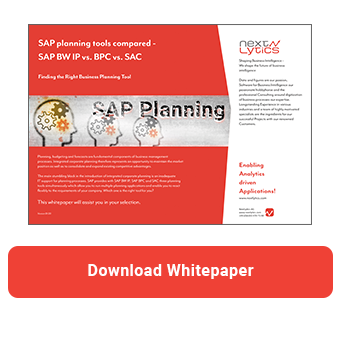SAP is positioning SAP Analytics Cloud (SAC) as the future strategic direction and is working intensively on new functions. This involves the use of new technologies such as AI and machine learning. Therefore, many companies ask themselves whether they should switch to SAC as a planning solution. In this article, I will cover all aspects in detail to make your decision easier.
The right Application
When deciding to use SAP Analytics Cloud as a planning tool, you should consider the field of application. SAC primarily targets business users and supports flexible planning scenarios. Possible area of application would therefore be decentralized departmental planning. The implementation is department and front-end controlled. The focus is on high flexibility and user friendliness.
The planning process is therefore flexible and department specific. The administration is executed decentralized by the users themselves. If these aspects are important for you, SAC is the right planning tool for your needs. However, keep in mind that decentralized planning is usually more prone to errors than centrally administered processes. If these plans are to be consolidated afterwards, problems are almost always to be expected.

The Advantages
A major advantage of SAP Analytics Cloud is the fact that reporting and analysis can be carried out independently by the business department. With SAC, self-service business intelligence becomes reality. Users are supported by the Smart Discovery function, which uses machine learning to examine the data and reveal valuable insights. Smart Discovery enables you to tap into new growth potential, such as new products or business areas. This function can also be used to optimize existing processes, such as supplier evaluation. So, if you are working in this direction, SAC will support you like no other planning tool currently available.
When making your decision, you should also consider that consolidation is not possible with SAP Analytics Cloud. If this is necessary for your planning, you can combine SAC with Business Planning and Consolidation (BPC).
In this case SAP makes it easy for you, as live connection to SAP BPC and S4/HANA is possible. This way you can access data in BPC without data transfer between the systems. Both read and write accesses are possible. Thanks to the mutual integration, you can carry out central financial activities in your BPC system and use this data as the basis for agile and simple department planning in SAP Analytics Cloud (SAC). In addition, data can also be loaded from many other data sources, such as SAP BW, SAP ECC or even Salesforce and IBM.
SAC also stands out positively in terms of the implementation time. Since it is a SaaS (Software as a Service) offer, there is no need for installation, operation and maintenance. Therefore, SAC can be implemented quickly. The Business Content provided by SAP also supports you in the rapid implementation. Therefore, if you want to use a web-based solution, SAC can be deployed without much development effort. Starting in the second quarter of 2020, a SAC Excel plug-in will be released, in which planning can be implemented in the familiar Excel interface. However, it remains to be seen to what extent the SAC planning feature can be used right from the start.
In summary, SAP Analytics Cloud enables users to create, control and maintain planning scenarios largely independently. SAC has an intuitive user interface and requires little technical knowledge. This makes the business department more independent of the IT and enables it to adapt planning more quickly and flexibly to the constantly changing market requirements. In addition, planning solutions can be introduced faster using SAC than integrated planning applications, that have to be developed in BW and require corresponding IT resources.
Planning Tools compared - SAP BW IP vs. BPC vs. SAC
Planning quality and costs
However, the planning quality may decrease, because more flexibility for the business users also offer more room for error. As a cloud application, SAC also offers fewer possibilities to intervene in the behaviour of the system. The advantage of SAC, however, is its fluent scalability. While on-premise applications require the purchase of new hardware, SAC makes upgrades effortless.
You should also consider the following points when making your decision. You should note that a separate license is required for SAP Analytics Cloud. If you are already using SAP BW, it means additional costs. However, since the software is maintained centrally, no manual updates are necessary. The entire service is offered from a single source. This eliminates costs for external partners and the commitment of internal personnel resources. This somewhat mitigates the license costs. Furthermore, there are no investment costs for the hardware. The SAC fees can be deducted as balance sheet-neutral monthly rates. When making your decision, you should weigh these factors against each other.
Our Conclusion - SAP Analytics Cloud Planning
SAP Analytics Cloud is mainly used when flexible planning is necessary. SAC is primarily aimed at business users and combines business intelligence, planning and simulation of business developments on one platform. Thanks to the intuitive user interface, users from the business department can easily run through ad-hoc scenarios and forecasts.
A parallel use of several planning instruments could also be considered. Companies can use BW-IP, BPC and SAC in parallel, depending on their requirements, and merge the results in the end. The functions of BW-IP and BPC are supplemented by ad-hoc plans as well as innovative AI and machine learning technologies from SAC. Thus, you can use SAC to transfer the latest data from BPC, perform analyses and simulations and then write the new data back to BPC.
SAP Analytics Cloud, SAP Planning


























